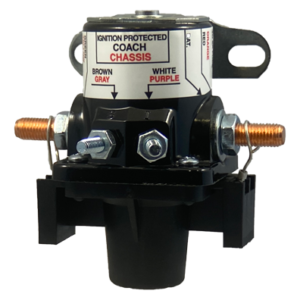The Basics of Battery Protection: Battery Disconnects
The battery disconnect solenoid and battery disconnect switch are both used to control the connection of the RV’s batteries to its electrical system, but they operate in different ways and are suited for different applications. Here’s a breakdown of the key differences:

(01-00055-000)
- Operation
- Battery Disconnect Solenoid:
- A solenoid is an electrically controlled switch (a relay) that can connect or disconnect the battery from the electrical system. It is typically operated remotely, often through a switch inside the RV, and it uses an electric current to control the connection.
- Battery Disconnect Switch:
- A battery disconnect switch is a manual switch that physically disconnects the battery from the RV’s electrical system. The switch is typically located near the battery, and you need to turn it on or off manually to connect or disconnect the battery.
- This switch is more straightforward and does not require any electrical power to operate, making it reliable in situations where battery power is already depleted.
- Battery Disconnect Solenoid:
- Usage
- Battery Disconnect Solenoid:
- Commonly used in more sophisticated RV setups where convenience is prioritized. It is particularly useful in motorhomes where the battery compartment might not be easily accessible.
- Allows for remote control, often integrated with the RV’s electrical control panel.
- Battery Disconnect Switch:
- Typically found in simpler or more cost-effective setups where direct manual control is sufficient. It’s often used in travel trailers or smaller RVs.
- Ideal for situations where the battery compartment is easily accessible and where simplicity and reliability are more important than remote operation.
- Battery Disconnect Solenoid:

(01-00058-000)
- Power Consumption
- Battery Disconnect Solenoid:
- Requires a small amount of electrical power to operate. While this is minimal, it does mean that the solenoid will not function if the battery is completely drained.
- Battery Disconnect Switch:
- Does not consume any power, as it is purely mechanical. This makes it more reliable in situations where conserving battery power is critical.
- Battery Disconnect Solenoid:
- Installation and Cost
- Battery Disconnect Solenoid:
- Typically more complex to install and more expensive than a manual switch. It requires wiring to a control switch inside the RV and possibly integration with other systems.
- Battery Disconnect Switch:
- Easier and less expensive to install. It usually requires only basic wiring and can be mounted directly near the battery compartment.
- Battery Disconnect Solenoid:
- Durability
- Battery Disconnect Solenoid:
- May have more components that can wear out over time, such as the electrical relay mechanism, though high-quality solenoids are generally quite durable.
- Battery Disconnect Switch:
- Very durable and simple, with fewer parts that can fail. Its mechanical nature makes it a long-lasting solution.
- Battery Disconnect Solenoid:
- Summary
- Battery Disconnect Solenoid:
- Offers remote, convenient control and is suited for situations where the battery compartment is not easily accessible. It requires electrical power to operate and is typically more complex and expensive.
- Battery Disconnect Switch:
- Provides manual, direct control of the battery connection, is simpler to install and use, and is highly reliable due to its mechanical nature with no power consumption.
- Battery Disconnect Solenoid:
The choice between a solenoid and a switch depends on your RV setup, convenience needs, and budget. Intellitec offers an automatic battery disconnect, the Battery Guard 1000, that prevents batteries from draining past a preset voltage threshold, keeping the battery with enough charge to operate the vehicle. Perfect for dry camping and vehicle’s with lots of drain on the battery. The Battery Guard 1000 can also be manually controlled via an LED push button switch.
